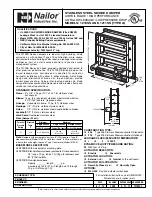
0160_IOM_1.2_Mar21_5
5
Nom. duct width
Opening width min.
Opening width max.
100-1,000mm
Nom. duct +194mm
Nom. duct +350mm
Nom. duct height Opening height min. Opening height max.
100mm
Nom. duct +100mm
Nom. duct +350mm
101-300mm
Nom. duct +125mm
Nom. duct +375mm
301-525mm
Nom. duct +150mm
Nom. duct +400mm
526-700mm
Nom. duct +175mm
Nom. duct +425mm
701-925mm
Nom. duct +200mm
Nom. duct +450mm
926-1,000mm
Nom. duct +225mm
Nom. duct +475mm
FIRE – 0160 ADJUSTABLE FRAME SYSTEM (IN WALL) FOR TWO HOUR FLEXIBLE SUPPORTING CONSTRUCTION
Preparation
1
Ensure that the damper is kept
in a clean dry environment and
that there is no damage to the
damper.
2
Remove all the packaging and
transit ties before installation.
3
Work out the opening size to be
cut using the adjacent table.
Patented Adjustable Frame System
(AFS) incorporating bracket, bracket
slot, and Z-piece
(Patent No: GB2557865)
Closure face board
Access door for
inspection / damper reset
0160 Series fire damper
Two layers of 50mm thick
140kg/m3 fire batt
M10 drop rods
15mm thick gypsum boards
Two hour rated flexible
supporting construction
to BS EN 1363-1:2020
Steel stud depth –
71 to 100mm
Installation sequence
4
The drywall will consist of two layers of 15mm plasterboard each side of steel studwork with an
optional mineral wool insulation. The opening will be a letterbox construction with overlapping layers
of plasterboard with an opening clearance around the damper casing in line with the above table.
5
Two M10 drop rods per fire damper shall be fitted centrally within the flexible wall fixed by steel anchors
into the slab or soffit above. These should be securely installed in line with the manufacturer’s fixing
instructions in a position to match the AFS rail.
6
The drop rods should have a nut screwed on for clamping the rail from above.
7
Slide the AFS rails on each side of the damper into the brackets and insert the “Z” piece into the
bracket slot pushing it up against the underside of the rail. Insert the 8mm bolt from above into the slot
through the “Z” piece fitting the nut until tight to secure the rail.
8
The damper should be mounted centrally in the opening as detailed in the drawing. The drop rods
are to slide through the slots in the rail and a nut screwed on to take the support of the damper rail.
The damper must then be levelled and when in the correct position the nut above the rail should be
tightened against the rail.
9
The galvanised mild steel ductwork connecting to the damper spigots must overlap by up to 40mm,
leaving a minimum 10mm clearance for any duct expansion in a fire situation.
10
The galvanised mild steel ductwork connections must be sealed with an approved galvanised mild
steel ductwork sealer and fixed with low resistance fixings such as aluminium rivets that will melt at
high temperature allowing the duct to break away without effecting the integrity of the installation.
11
The connecting galvanised mild steel ductwork must be independently supported within one metre of
the connections and have been installed in accordance with DW144.
12
The gap between the damper and the wall opening will need filling with two layers of 50mm thick 140kg/m3
fire batt cut to an interference fit and pushed in to place. All cut edges must be sealed with a firebatt
sealant to BS EN 13501-2. A fire rated intumescent mastic to BS EN 13501-2 shall be applied to each joint.
13
A closure face board of 15mm plasterboard is screwed to each side of the of the wall. It must fully cover
the fire batt and overlap the opening by 50mm.
14
An access door should be fitted on the access side of the damper to enable the resetting of the
damper blades.
15
When the damper installation has been completed checks should be made to ensure the drop rods
are secured to the cleats and there is no movement, operation of the damper should be checked.
16
Complete DW145 Fire Damper Certificate.
PRODUCT
0160 W/ AFS RAIL
APPLICATION
FLEXIBLE SUPPORTING CONSTRUCTION, SUPPORT IN WALL
CLASSIFICATION REPORT NO.
BRE 287811C
CLASSIFICATION
E120 (VE I
O)
TESTED INSTALLATION METHOD SHOWN. DIFFERING INSTALLATION METHODS TO THIS MUST BE APPROVED BY THE BUILDING CONTROL AUTHORITY (BCA) BEFORE PROCEEDING.
















